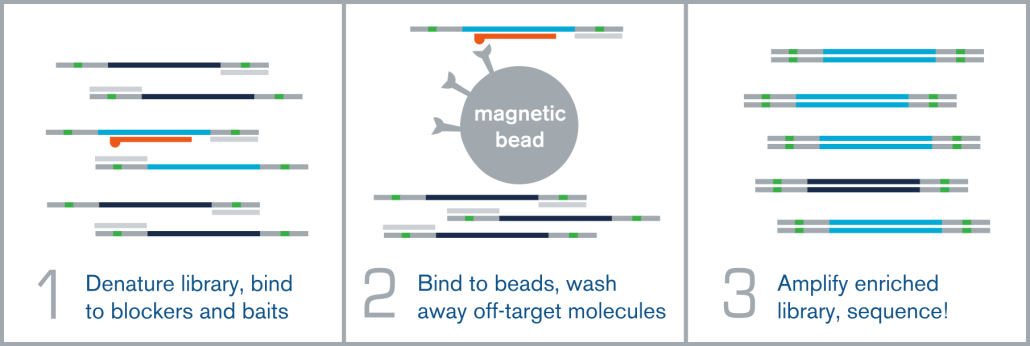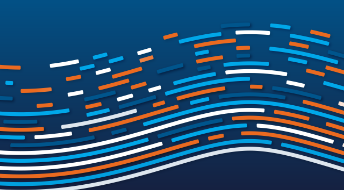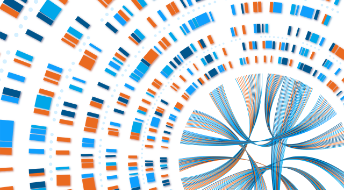Overview
For more than a decade, the myBaits® team has provided customized, high-performance hybridization capture kits for human, plant, animal, bacterial, and viral research from a wide variety of sample substrates and qualities. myBaits Custom Hybridization Capture Kits are perfect for new or expert users, offering a simple protocol that delivers consistent and reproducible results.
- Reduce your per-sample sequencing costs while increasing the accuracy and power of your data analysis.
- Hybridization capture of NGS library molecules using biotinylated baits provides the best combination of ease, efficiency, and cost-effectiveness.
- Our proprietary oligo synthesis platform provides flexible production of high-quality baitsets for any project size.
myBaits kits can be easily integrated into your own research workflow, or in our customizable Sequencing or Bioinformatics services. Pair with our Library Prep Kit or bring your own for a complete targeted NGS workflow solution.
myBaits kits are for research use only and are not validated for diagnostic or therapeutic purposes.
Key benefits
Specificity and sensitivity—myBaits chemistry delivers a high percentage of on-target reads (specificity) without sacrificing the unique target molecule complexity (sensitivity).
Novel variant discovery—Detect any amenable mutation type, including SNPs, indels, rearrangements, CNVs, and more.
Capture any molecule—Since myBaits probes are completely independent of the enriched library, they can capture molecules of any length.
Flexible workflows meet your needs—myBaits kits are designed to be paired with ours or any other upstream library prep kit and any downstream NGS platform.
Detect rare target molecules—High-sensitivity protocol enables high specificity of rare targets from challenging samples without sacrificing sensitivity.
Preserve relative abundance—Unlike other targeted sequencing techniques, myBaits maintains the relative abundance signals between target types with minimal bias.
Wide range of target types—Daicel Arbor’s flexible oligo synthesis enables focused NGS for any total target size, from a single locus to hundreds of megabases.
Flexible reagents—You can deploy your myBaits in-solution reagents in any manner to fit your project, whether running one or hundreds of captures at once.
myBaits kits are for research use only and are not validated for diagnostic or therapeutic purposes.
Product selector
To help select the correct myBaits Custom Kit for your project, consult the table below.
| Purpose | Research | Sample Types | Product |
|---|---|---|---|
| Enriching NGS libraries built from extracted DNA | Gene or exon resequencing, novel variant discovery, phylogenetics, transgene detection, and more | Genomic DNA, metagenomic DNA, environmental DNA, ancient DNA, museum DNA, FFPE samples, cfDNA, ctDNA, plant, animal, virus, bacteria, human, and more | myBaits DNA-Seq Learn More |
| Enriching NGS libraries built from extracted RNA/cDNA | Gene expression profiling and/or rare transcript detection | Transcriptomic RNA, environmental RNA, viral or pathogen RNA, human, plant, animal, bacteria, degraded RNA, and more | myBaits RNA-Seq Learn More |
| Enriching NGS libraries built from bisulfite- or enzymatic-converted NGS libraries | Epigenetic methylation sequencing | Bisulfite- or enzymatic-converted DNA for methylation sequencing | myBaits Methyl-Seq Learn More |
myBaits kits are for research use only and are not validated for diagnostic or therapeutic purposes.
Resources
Product Literature
Poster
A universal targeted sequencing system for any high-throughput sequencing platform
myBaits kits are for research use only and are not validated for diagnostic or therapeutic purposes.
FAQs
No. myBaits hybridization capture kits have always been-- and will continue to be-- compatible with any user-provided upstream NGS library preparation system that is appropriate for a given project.
However, for your convenience, we are now offering our own powerful kit for preparing NGS libraries from most types of DNA samples, which is relevant for many myBaits hybridization capture projects. This new product (Library Preparation Kit for myBaits) is intended to be used for the preparation of NGS libraries from dsDNA samples prior to hybridization capture with myBaits.
In addition to the upstream library preparation steps, the Library Prep Kit for myBaits includes the reagents necessary for performing the post-capture amplification step of the myBaits protocol.
- Biotinylated RNA probes, with sequences corresponding to your custom design or a predesigned catalog option
- Hybridization and wash reagents
- For myBaits Custom kits, optional custom probe design informatics service (= expert bioinformaticians design and filter bait sequences and provide summary report and recommendations)
You will receive enough probes and reagents for performing the stated number of individual capture reactions of your kit size (e.g., 16 reactions) according to our current protocol. Please note that there are some additional reagents and equipment you will need to supply in order to perform a myBaits capture. Please review the list of required materials in the applicable myBaits manual to make sure you have everything you need before starting your experiments.
We also offer reagents for preparing libraries from DNA samples in advance of performing the myBaits hybridization capture step. Please visit Library Prep Kit for myBaits for more information.
If you are looking to outsource your project to a full-service laboratory and bioinformatics services group, please visit our myReads NGS laboratory and bioinformatics services page for more information about our comprehensive targeted sequencing service options (library preparation, target capture, next-generation sequencing, and optional analysis).
In this context, we use the terms interchangeably. Some fields prefer one term over the other, so we use both terms.
For new myBaits Custom baitset designs, the estimated manufacturing lead time is ~3-4 weeks minimum, starting from when your order is received and you have approved the final design. In addition, please consider that if you utilize our included bait design services, we will typically be in correspondence for an additional upfront period (up to several weeks) regarding a design before manufacturing can begin. Please also remember to accommodate any additional time for your collaborators to approve the final design, if applicable.
For myBaits Expert (catalog) kits or reorders of myBaits Custom kits with designs previously manufactured by Daicel Arbor Biosciences, the estimated manufacturing lead time is up to ~1-2 weeks from the time an order is received.
All myBaits kits include a specific protocol for their use as well as almost all of the reagents required to deploy them. In the manual, you will find the complete list of required supplies (reagents and equipment) that you will need in order to perform the captures.
Please see the applicable myBaits manual for detailed protocol instructions for enriching from Standard, High-Sensitivity, Long-Insert, or other specialty target/sample types.

Hybridization capture is integrated into the overall NGS workflow immediately before sequencing on an NGS platform, such as Illumina. A fully sequenceable, barcoded/indexed NGS library (or pool of multiple libraries) is denatured, and allowed to anneal to complementary target-specific biotinylated probes/baits. These bait:library complexes are then bound to streptavidin-coated magnetic beads via the biotin on the probes, which are washed to remove non-specifically bound molecules. The remaining “enriched” library molecules are then released from the baits and amplified before sequencing.
Note! You may know the “hybridization capture” technique by another name, such as:
- Target enrichment
- Target capture
- Probe capture
- Exon capture
- Capture sequencing / sequence capture
- Hybridization sequencing / hyb-seq
- Hybridization capture / hyb-cap
Specific recommendations for per-library input mass for different enrichment project types can be found in the applicable myBaits manual.
Target capture necessarily requires subjecting your libraries to a bottleneck, wherein target molecules are captured and therefore enriched, and non-target molecules are therefore removed. To have sufficient unique molecules for good sequencing coverage of your targets, successful captures DEPEND on the input of sufficiently complex libraries.
For best results, it is recommended that only amplified (non-PCR-free) NGS libraries are used for target capture. This provides multiple copies of each starting template molecule, increasing the chance of each individual molecule getting enriched. However if you need more starting material to reach the recommended amount, it is generally preferable to generate more library from fresh genomic DNA or a new batch of indexed library, rather than through extra amplification. This is because while some amplification is good, over-amplification risks reducing the observable complexity of your libraries through the uneven action of PCR bias, as some molecules will become relatively more abundant while others become rare. This is also true for manipulating your libraries after capture: amplify your post-capture libraries the minimum number of cycles necessary to reach the molarity required by your sequencing facility.
The applicable myBaits manual covers some common technical questions and troubleshooting topics at the end of each protocol. Please read through the relevant section first as it may answer your question. If you still have an issue, please contact us via email at techsupport_at_arbor.daicel.com or reach out to your most recent contact person for assistance.
When ordering your myBaits kit, please indicate the sequencing library configuration you intend to enrich. The standard adapter blocking reagent provided with the kit (Block X) is compatible with Illumina® TruSeq®-style or Nextera®-style libraries with single 6-12 bp or dual 6-12 bp indexing. These options cover the vast majority of currently available commercial library preparation systems intended for sequencing on any Illumina platform.
For different adapter configurations than those described above, we recommend ordering Custom IDT® xGen® Blocking Oligos. At a concentration of 1 μg/μL, custom adapter-blocking oligos can be used in lieu of myBaits Block X.
If you are not certain, or later decide to change your library prep kit, please contact us so we can instruct you on how to obtain the correct blocking oligos.
Yes! Our expert myReads team provides a range of in-house NGS services, including library preparation, target capture with myBaits, high-throughput sequencing, and optional bioinformatics analysis. Visit the Sequencing Services page to learn more about our comprehensive laboratory and sequencing service options!
Yes! As long as we receive written permission from the original designer(s) (if it is not your kit and the bait sequences are not publicly available), you can re-order any past design that has been manufactured by Daicel Arbor Biosciences. We can usually provide such re-orders within ~1-2 weeks of ordering.
Sequence Submission Guidelines [PDF]
Please gather your target sequences in FASTA format or as genomic coordinates according to our guidelines, and contact us with details of your project. Our team will provide you with an estimated panel size as soon as possible based on your provided information. Please let us know upfront if there is a specific panel size in which your design should be constrained (e.g. not more than 60,000 probes) so that together we can adjust your design/estimate accordingly. Otherwise, our experts will determine the best size of panel based on your targets and project configuration.
myBaits Custom kits have frequently achieved high on-target percentages for a wide range of applications. However since it is not possible to predict the behavior of new baitsets (e.g. on-target percentage, unique read depth, and evenness of coverage) without experimental test data, and knowledge of your experimental parameters, we are unable to provide specific predictions for downstream sequencing performance. Factors such as the overall size and GC content of the bait sequences, the sequence divergence between baits and targets, the quality of your NGS libraries, and the sequencing depth will also have significant impacts on post-enrichment outcomes.
If sequencing efficiency is critical to your project, best practice for optimizing new target capture designs is to perform a pilot test to determine the behavior of the baitset under your chosen conditions and with your samples, and adjust parameters such as sequencing depth, hybridization stringency, or number of capture rounds accordingly. For example, to maximize your on-target percentage, you could consider making upfront protocol adjustments such as performing two consecutive rounds of capture, as long as you are working with sufficiently high-quality, complex libraries.
Singleton and/or short stretches of N’s will be replaced with T’s to facilitate bait design in these regions. Longer stretches (e.g 10+ N’s) will be skipped over during bait placement.
Ambiguities (e.g. Y/M/R/S/W/K) are allowed, but will be replaced by ONE random candidate base for manufacturing, since we only synthesize A/T/C/G bases (no mixed bases). The hybridization capture system tolerates multiple mismatches between probe:target molecules. However, sequences that contain on average >5-7% ambiguous bases are not recommended. If you are providing consensus sequence(s) generated from a common locus/gene source (e.g. the same gene from multiple genomes, or multiple alleles of a target gene), please provide the original individual sequences. Our informatics experts can remove redundant/similar regions during the design process to ensure all variants are sufficiently represented while minimizing overall unique bait count.
We are pleased to provide as much bait design advice and assistance as possible. However we are unlikely to be sufficiently knowledgeable in your particular field as to help you pick the specific genes/targets for your project. Whether this is your first NGS project and/or you are an experienced genetics researcher, we always recommend that you choose your targets in collaboration with your full research team, especially your bioinformatician(s), so that your kit design is as robust as possible.
Some general suggestions appropriate for many projects would be to exhaustively survey the literature for your organism(s), and consider including neutral and/or control loci in addition to specific targets of interest. You should include enough loci and/or SNPs to draw significant conclusions within the number of specimens that you plan to survey. You should make sure that you have thoroughly evaluated your bait design before proceeding with your kit order.
If you are beginning a completely new project, you may wish to order the smallest number of reactions upfront, and place a reorder for a larger number of reactions once you have tested the design. However please note that any changes to your design (adding or removing baits) would be ordered as a fully new custom kit, which may have a longer delivery time than a reorder of a previous design.
myBaits kits are for research use only and are not validated for diagnostic or therapeutic purposes.






